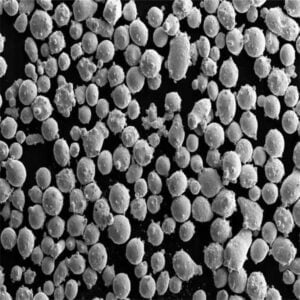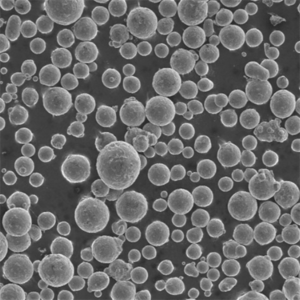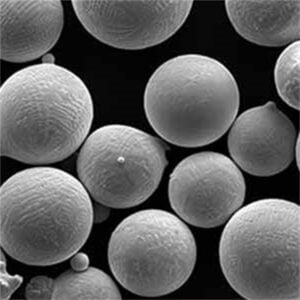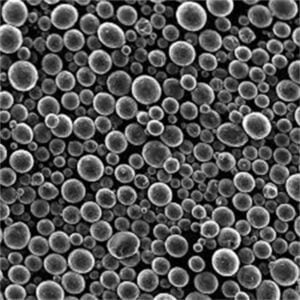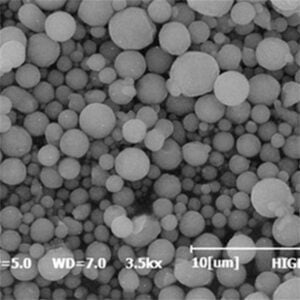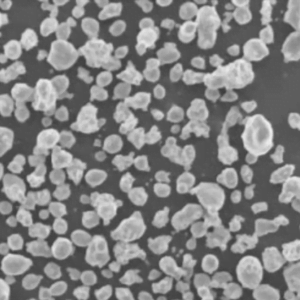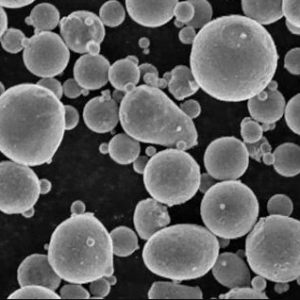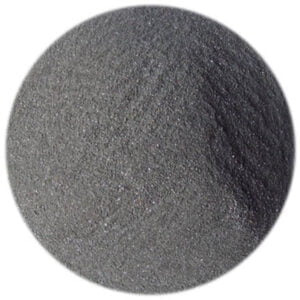17-4PH rostfritt stål pulver
Innehållsförteckning
Föreställ dig att du bygger en komponent som måste vara otroligt stark, korrosionsbeständig och lätt på samma gång. Låter som en svår uppgift, eller hur? För dem som arbetar med additiv tillverkning (AM) kan denna dröm bli verklighet i och med introduktionen av 17-4PH rostfritt stål pulver speciellt utformad för varm isostatisk pressning (HIP).
Den här artikeln dyker djupt in i 17-4PH för HIP och utforskar dess egenskaper, tillämpningar, fördelar, begränsningar och olika tillgängliga metallpulveralternativ. Vi ger dig den kunskap som krävs för att fatta välgrundade beslut om att införliva detta kraftfulla material i ditt nästa AM-projekt.
17-4PH:s hemligheter: En uppdelning av kompositionen
17-4PH rostfritt stål, även känt som UNS S17400, tillhör den utskiljningshärdande (PH) familjen av rostfria stål. Här är en närmare titt på dess nyckelkomponenter:
| Element | Vikt % | Roll |
|---|---|---|
| Krom (Cr) | 15-17.5 | Förbättrar korrosionsbeständigheten |
| Nickel (Ni) | 3.5-5.5 | Förbättrar hållfasthet och duktilitet |
| Koppar (Cu) | 3-4 | Bidrar till utskiljningshärdning |
| Columbium (Cb) (Niobium (Nb)) | 0.4-1.2 | Främjar utskiljningshärdning |
| Kisel (Si) | 1 max | Förbättrar hållfasthet och oxidationsbeständighet |
| Mangan (Mn) | 1 max | Förbättrar härdbarheten |
| Kol (C) | 0,07 max | Avgörande för utskiljningshärdning |
| Järn (Fe) | Balans | Basmetall |
Denna unika sammansättning ger 17-4PH exceptionella mekaniska egenskaper, vilket gör det till ett mycket eftertraktat material för krävande applikationer.
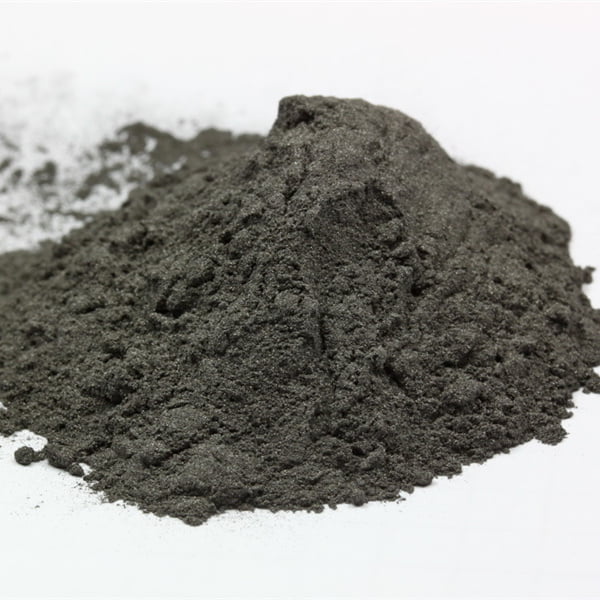
Att välja rätt passform för ditt projekt
Det fina med att använda 17-4PH för HIP är att det finns så många olika metallpulver att välja mellan. Varje pulver har lite olika egenskaper, vilket gör att du kan skräddarsy materialet efter dina specifika behov. Här är en uppdelning av tio framstående 17-4PH metallpulver för HIP:
1. LPW® 17-4 PH rostfritt stål (LPW)
Detta gasatomiserade pulver ger utmärkt flytbarhet och packningstäthet, vilket leder till högkvalitativa konstruktioner. Det är ett populärt val för tillämpningar inom flyg- och rymdindustrin, fordonsindustrin och den medicinska sektorn.
2. EOS rostfritt stål 17-4PH (EOS)
EOS erbjudande ger en jämn partikelstorleksfördelning och sfärisk morfologi, vilket främjar god tryckbarhet och mekaniska egenskaper. Den är väl lämpad för komplexa geometrier och krävande konstruktionsdelar.
3. Admatec 17-4PH (Admatec)
Detta kväveatomiserade pulver har hög renhet och låg syrehalt, vilket resulterar i förbättrad mekanisk prestanda efter HIP. Det används inom olje- och gasindustrin samt inom kemisk processindustri.
4. Höganäs AM 17-4PH (Höganäs)
Höganäs pulver är känt för sin exceptionella flytbarhet och sina laserabsorptionsegenskaper. Detta ger effektiva tryck och konsekventa konstruktioner, vilket gör det idealiskt för högvolymsproduktion.
5. Snickartillsats AM 17-4PH (snickare)
Carpenters metallpulver genomgår en unik tillverkningsprocess för ökad renhet och minimala inre defekter. Detta leder till överlägsna mekaniska egenskaper för kritiska delar inom flyg- och rymdindustrin.
6. SLM lösningar 17-4PH (SLM Solutions)
Detta gasatomiserade pulver har en smal partikelstorleksfördelning, vilket möjliggör exakt kontroll över mikrostrukturen och de slutliga egenskaperna hos detaljen. Det är lämpligt för applikationer som kräver hög måttnoggrannhet och hållfasthet.
7. Oerlikon AM 17-4PH (Oerlikon)
Oerlikons pulver är kväveatomiserat för förbättrad flytbarhet och packningstäthet. Företaget vänder sig till ett brett spektrum av industrier, inklusive fordons-, medicin- och flygindustrin.
8. Element 17-4PH (Element)
Detta gasatomiserade pulver prioriterar hög sfäricitet och flytbarhet för optimal tryckbarhet. Det är ett kostnadseffektivt alternativ för allmänna tillämpningar inom olika branscher.
9. AP&C 17-4PH (AP&C)
AP&C:s pulver erbjuder en balans mellan kostnad och prestanda och ger bra tryckbarhet och mekaniska egenskaper för mindre krävande applikationer.
10. DMG MORI 17-4PH (DMG MORI)
Detta gasatomiserade pulver är speciellt anpassat för DMG MORIs system för laseradditiv tillverkning.
Tillämpningar av 17-4PH rostfritt stål pulver
De exceptionella egenskaperna hos 17-4PH för HIP öppnar upp för ett stort antal applikationer inom olika branscher. Här är några viktiga områden där detta kraftfulla material briljerar:
- Aerospace: 17-4PH:s höga förhållande mellan styrka och vikt, utmärkta korrosionsbeständighet och utmattningshållfasthet gör det idealiskt för flygplanskomponenter som landningsställ, motorfästen och strukturella komponenter. Jämfört med traditionella material som aluminium- eller titanlegeringar erbjuder 17-4PH överlägsen mekanisk prestanda samtidigt som vikten hålls nere, vilket är en avgörande faktor för bränsleekonomi och flygsträcka.
- Fordon: Fordonsindustrin använder 17-4PH för högpresterande komponenter som växlar, upphängningsdelar och lättviktsfästen. Dess förmåga att motstå slitage och dess styrka gör det till en värdefull tillgång i krävande fordonsapplikationer. Jämfört med tyngre stålkomponenter erbjuder 17-4PH viktminskningsfördelar, vilket bidrar till förbättrad bränsleeffektivitet och övergripande fordonsprestanda.
- Medicinsk: 17-4PH:s biokompatibilitet, i kombination med dess korrosionsbeständighet och styrka, gör det lämpligt för olika medicinska implantat. Tillämpningarna omfattar kirurgiska instrument, protetiska komponenter och till och med ryggradsimplantat. Här sticker 17-4PH ut jämfört med traditionella material som rostfritt stål 316L genom att erbjuda ett överlägset förhållande mellan styrka och vikt, vilket möjliggör lättare implantatkonstruktioner som förbättrar patientens komfort och funktionalitet.
- Olja och gas: Olje- och gasindustrin förlitar sig på 17-4PH för komponenter som måste tåla tuffa miljöer. Dess motståndskraft mot korrosion och höga tryck gör den idealisk för borrhålsverktyg, ventiler och komponenter i brunnshuvuden. Jämfört med vissa nickelbaserade legeringar som traditionellt används, erbjuder 17-4PH ett kostnadseffektivt alternativ samtidigt som den nödvändiga styrkan och korrosionsbeständigheten bibehålls för dessa krävande applikationer.
- Gjutning och matriser: Den höga slitstyrkan och hållfastheten hos 17-4PH gör det till ett värdefullt material för forminsatser, verktygsfixturer och matriser som används i olika tillverkningsprocesser. I jämförelse med verktygsstål som används i traditionella applikationer erbjuder 17-4PH potentialen för lättare formkonstruktioner med förbättrad värmeledningsförmåga, vilket leder till snabbare produktionscykler.
Utöver dessa huvudtillämpningar används 17-4PH för HIP i flera andra branscher, bland annat
- Försvar och militär: Komponenter som kräver hög hållfasthet i förhållande till vikt och korrosionsbeständighet.
- Konsumentvaror: Högpresterande sportartiklar och komponenter till lyxklockor.
- Kemisk bearbetning: Komponenter som måste kunna hantera frätande kemikalier och höga tryck.
Mångsidigheten hos 17-4PH för HIP gör det till ett verkligt transformativt material som flyttar fram gränserna för vad som är möjligt inom additiv tillverkning.
Kraft och förmåner: Fördelar med 17-4PH för HIP
Synergin mellan 17-4PH och HIP erbjuder en rad fördelar som gör denna kombination till en föregångare inom AM:
- Exceptionella mekaniska egenskaper: HIPping eliminerar inre porositet i den tryckta delen, vilket leder till betydande förbättringar av draghållfasthet, utmattningshållfasthet och övergripande mekanisk prestanda jämfört med icke-HIPpade delar. Detta gör det möjligt att skapa lättviktskomponenter som tål krävande belastningar.
- Förbättrat korrosionsmotstånd: 17-4PH har en inneboende korrosionsbeständighet tack vare sin kromhalt. HIPping förtätar materialet ytterligare, vilket minimerar möjligheterna till korrosionsinitiering.
- Designfrihet och komplexitet: Till skillnad från traditionella tillverkningsmetoder gör AM det möjligt att skapa komplexa geometrier med interna kanaler och invecklade funktioner. 17-4PH:s flytbarhet och tryckbarhet gör den idealisk för att förverkliga dessa intrikata mönster.
- Lättviktspotential: Det höga förhållandet mellan styrka och vikt hos 17-4PH möjliggör en betydande viktreduktion jämfört med traditionella material. Detta är särskilt fördelaktigt i tillämpningar som flyg- och fordonsindustrin, där varje sparat gram innebär förbättrad bränsleeffektivitet och prestanda.
- Materialeffektivitet: AM minimerar materialavfallet jämfört med traditionella subtraktiva tillverkningstekniker. Detta, i kombination med den höga densitet som uppnås genom HIPping, minskar den totala materialåtgången.
Begränsningar av 17-4PH för HIP
Även om 17-4PH för HIP har ett imponerande utbud av fördelar är det viktigt att erkänna dess begränsningar:
- Kostnad: Kostnaden för 17-4PH metallpulver och HIPping-processen kan vara högre jämfört med vissa traditionella material och tillverkningstekniker. Prestandafördelarna och potentialen för viktminskning kan dock ofta kompensera för den initiala kostnaden, särskilt för applikationer med högt värde.
- Begränsningar av delstorleken: Nuvarande AM-byggvolymer begränsar storleken på de komponenter som kan tillverkas med 17-4PH. Detta kan utgöra en utmaning för vissa storskaliga applikationer.
- Ytjämnhet: Additiva tillverkningsprocesser kan resultera i en något grövre ytfinish jämfört med vissa traditionella tekniker som maskinbearbetning. Efterbearbetningstekniker som polering eller blästring kan dock mildra detta problem.
- Materialkvalificering: För vissa kritiska applikationer, särskilt inom flyg- och medicinsektorn, kan omfattande materialkvalificeringstestning krävas för att säkerställa prestandan hos 17-4PH-delar som tillverkas via AM och HIP.
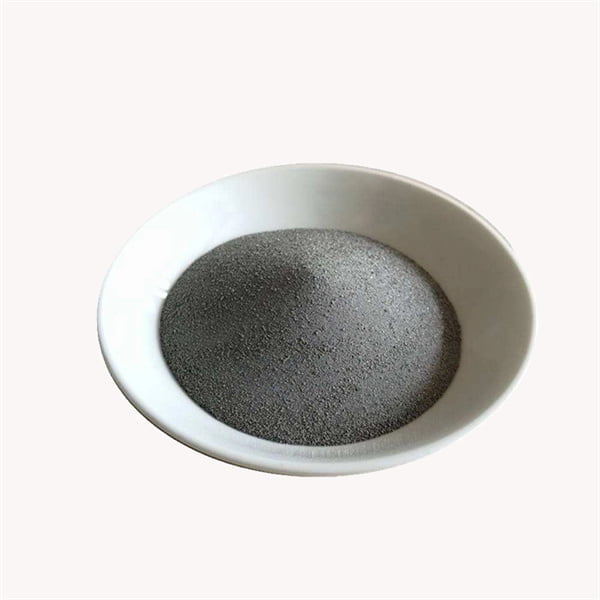
Fördelar kontra nackdelar med 17-4PH för HIP
Tabell: För- och nackdelar med 17-4PH för HIP
| Funktion | Proffs | Nackdelar |
|---|---|---|
| Mekaniska egenskaper | Exceptionell styrka, utmattningshållfasthet och slitstyrka efter HIPping | Kan kräva ytterligare efterbearbetning för vissa applikationer |
| Motståndskraft mot korrosion | Inbyggd korrosionsbeständighet, ytterligare förbättrad genom HIPping | Kostnaden för metallpulver och HIP-process kan vara högre |
| Designfrihet | Möjliggör komplexa geometrier och lättviktskonstruktion | Nuvarande AM-byggvolymer begränsar detaljstorleken för vissa applikationer |
| Materialeffektivitet | Minimerar materialspill jämfört med traditionella metoder | Ytjämnheten kan vara högre jämfört med maskinbearbetning |
| Kvalificering | Kan kräva omfattande materialkvalificering för kritiska applikationer | Erbjuder en balans mellan prestanda, designflexibilitet och viktbesparingar |
I slutändan beror beslutet att använda 17-4PH för HIP på de specifika applikationskraven och en noggrann utvärdering av för- och nackdelar.
Avmystifiering av detaljerna: Specifikationer, storlekar, kvaliteter och standarder
Här är en uppdelning av viktiga specifikationer, storlekar, kvaliteter och relevanta standarder för 17-4PH metallpulver för HIP:
Tabell: Specifikationer, storlekar, kvaliteter och standarder för 17-4PH metallpulver för HIP
| Funktion | Detaljer |
|---|---|
| Materialspecifikation | ASTM International ASTM F3055 |
| Kemisk sammansättning | Se tabellen i avsnittet "Avslöja 17-4PH:s hemligheter" för uppdelning |
| Fördelning av partikelstorlek | Varierar beroende på tillverkare, varierar vanligtvis mellan 15-45 mikron |
| Sfäriskhet | Hög sfäricitet är att föredra för optimal flytbarhet och tryckbarhet |
| Flytbarhet | Avgörande för jämn pulverspridning och skiktbildning under tryckningen |
| Skenbar densitet | Vanligtvis varierar mellan 4,6 och 5,0 g/cm³ |
| Betyg | Finns i tillstånd H1150 (lösglödgat) och tillstånd H1025 (åldrat) |
| Standarder | Kan uppfylla olika branschstandarder som AMS och NADCAP |
Obs! Denna tabell ger en allmän översikt. Specifika detaljer avseende krutspecifikationer och certifieringar kan variera beroende på tillverkare.

Leverantörer & priser på 17-4PH metallpulver för HIP
Flera ledande leverantörer av metallpulver erbjuder 17-4PH speciellt utformat för HIP-applikationer. Här är några framstående aktörer (utan inbördes ordning):
- LPW
- EOS GmbH
- Admatec GmbH
- Höganäs AB
- Snickare Tillsats
- SLM Solutions GmbH
- Oerlikon AM
- Element Materialteknik
- AP&C Koppartillsats
- DMG MORI Co, Ltd.
Prissättning: Kostnaden för 17-4PH metallpulver för HIP kan variera beroende på tillverkare, partikelstorleksfördelning och orderkvantitet. Generellt sett kan du förvänta dig en högre prispunkt jämfört med vissa andra metallpulver på grund av legeringselementen och de specialiserade tillverkningsprocesserna som är inblandade.
Det är viktigt att rådgöra med enskilda metallpulverleverantörer för aktuell prisinformation och specifika offerter.
VANLIGA FRÅGOR
Tabell: Vanliga frågor om 17-4PH för HIP
| Fråga | Svar |
|---|---|
| Vilka är fördelarna med att använda HIP med 17-4PH? | HIPping eliminerar inre porositet, vilket leder till betydande förbättringar av mekaniska egenskaper, korrosionsbeständighet och övergripande kvalitet på detaljerna. |
| Hur står sig 17-4PH för HIP jämfört med traditionella tillverkningsmetoder? | AM med 17-4PH erbjuder designfrihet, potential för lättvikt och minskat materialspill jämfört med subtraktiva tillverkningstekniker. Begränsningar i fråga om kostnad och detaljstorlek kan dock behöva beaktas. |
| Vilka är några typiska användningsområden för 17-4PH för HIP? | Flyg- och rymdindustrin, fordonsindustrin, medicinteknik, olja och gas, gjutning och formning samt många andra industrier som kräver högpresterande komponenter. |
| Vilka faktorer bör jag tänka på när jag väljer en leverantör av metallpulver för 17-4PH för HIP? | Tänk på faktorer som pulverspecifikationer, certifieringar, prissättning och leverantörens rykte och erfarenhet inom AM |
Dela på
MET3DP Technology Co, LTD är en ledande leverantör av lösningar för additiv tillverkning med huvudkontor i Qingdao, Kina. Vårt företag är specialiserat på 3D-utskriftsutrustning och högpresterande metallpulver för industriella tillämpningar.
Förfrågan för att få bästa pris och anpassad lösning för ditt företag!
Relaterade artiklar

Högpresterande segment för munstycksvingar: Revolutionerande turbineffektivitet med 3D-utskrift i metall
Läs mer "Om Met3DP
Senaste uppdateringen
Vår produkt
KONTAKTA OSS
Har du några frågor? Skicka oss meddelande nu! Vi kommer att betjäna din begäran med ett helt team efter att ha fått ditt meddelande.

Metallpulver för 3D-printing och additiv tillverkning
FÖRETAG
PRODUKT
cONTACT INFO
- Qingdao City, Shandong, Kina
- [email protected]
- [email protected]
- +86 19116340731






